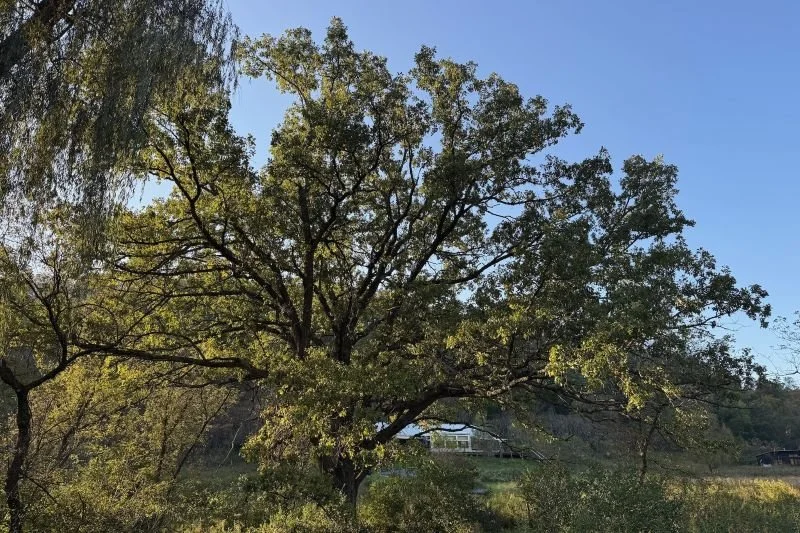The Mighty Oak: A Madison Mainstay
The iconic oaks trees at Pope Farm Conservancy, just outside Madison, Wisconsin.
Key Take-Aways
1. Oak trees are a keystone species in Southern Wisconsin, protecting urban and rural environments.
2. Dane County oak trees provide shelter and food to animals, including birds, mammals, insects, and reptiles.
3. Madison, Wisconsin, oak trees provide cooling shade, reduce soil erosion, absorb air pollution, and capture tons of carbon, helping fight climate change.
Of the many tree species we see in the Madison area, few impress more than the mighty oak (Quercus). Found throughout our urban forests, from woodlands and wild spaces to schoolyards and backyards, these giants are as amazing as they are abundant.
Not only are oak trees stately and beautiful, but they are also a keystone species, providing so many benefits that without them, nearby ecosystems may break down. That’s a lot of responsibility for one type of tree, so let’s take a look at how the oak works its wonders.
Venerable Varieties
Southern Wisconsin oaks tend to look pretty similar, but several different species thrive in the area. In the United States, we group our oaks into white oaks and red oaks. The most common white oak species in Southern Wisconsin are the White Oak (Quercus alba), Bur Oak (Quercus macrocarpa), and Swamp White Oak (Quercus bicolor). You can tell if your tree is in the white oak group if its leaves have rounded edges. White oaks are among the longest-lived of the species, with an average lifespan of 300-400 years.
Madison’s red oaks include the Red Oak (Quercus rubra), Black Oak (Quercus velutina), and some Red/Black Hybrid Oaks. The leaves on red oak varieties have spiky ends on their distinctive leaves.
Wildlife Warriors
Oaks are relatively slow-growing, long-lived trees that produce a reliable food source for deer, squirrels, birds, and other animals. Acorn production varies depending on the age and variety of the tree. A common acorn-eater in the Madison area is the turkey.
As oak trees get bigger and older, they also begin providing shelter for many of the same animals that they feed. Once the leaves fall from your oak trees in the autumn, you’ll notice squirrel nests aplenty in the city and hear woodpeckers at work. In wooded areas with both live and fallen oaks, the trees burst with life. Foxes, salamanders, frogs, snakes, raccoons, butterflies, spiders, and more all take shelter in the leaves, branches, and hollow spaces of oaks.
Eco-Exceptional
A big contributor to the oak’s keystone status is its contribution to the local environment. This includes its ability to feed and shelter wildlife, but extends to the very soil in which it grows.
Mature oak trees, with their large canopies, offer a remarkable number of ecological benefits.
· Shade. They provide shade in the summer, cooling urban neighborhoods and reducing excessive heat zones in our cities. In your yard, that same shade offers relief for wildlife and homeowners. Homes with big oaks for shade need less air conditioning than their full-sun neighbors.
· Leaf Litter. Is it a pain to rake leaves? Sure, so why not leave some of them? Oak leaves are slow to decompose, making them ideal winter havens for insects, caterpillars, and other tiny creatures vital to a robust ecosystem. When they do break down, they enrich the soil, providing essential nutrients for all of the surrounding plants.
· Erosion Control. That big oak canopy is hard at work even on rainy days. In fact, the beautiful summer leaves slow and disperse rain so that the soil gets even, controlled moisture. A heavy rain is less likely to wash away the soil beneath a mature oak. Those same trees have extensive root systems that help stabilize the soil and further prevent erosion.
· Carbon Capture. Oak trees are champion climate protectors. When leaves absorb carbon dioxide and produce oxygen via photosynthesis, they also absorb air pollutants, giving us cleaner air to breathe. That carbon dioxide is the carbon that contributes to climate change. According to 8 Billion Trees, a 50-year-old White Oak tree (just a baby in white oak years) stores 36 tons of carbon while producing 96 tons of oxygen.
A large Bur Oak in Viroqua, Wisconsin
The Care and Feeding of Madison Oak Trees
Oak trees are important to our urban forest. The trees downtown, in yards, and in our many parks and woodlands are far more than just beautiful. They are ecosystem champions that require care to remain safe and healthy.
Wisconsin oaks are vulnerable to some diseases, oak wilt in particular. With regular inspection, you can catch problems early and keep them from killing your valuable oak trees. Oaks must be pruned when they are dormant, so make an appointment to have them trimmed during the winter.
If you have questions about caring for your oak trees or planting new ones, contact us for a free consultation.



